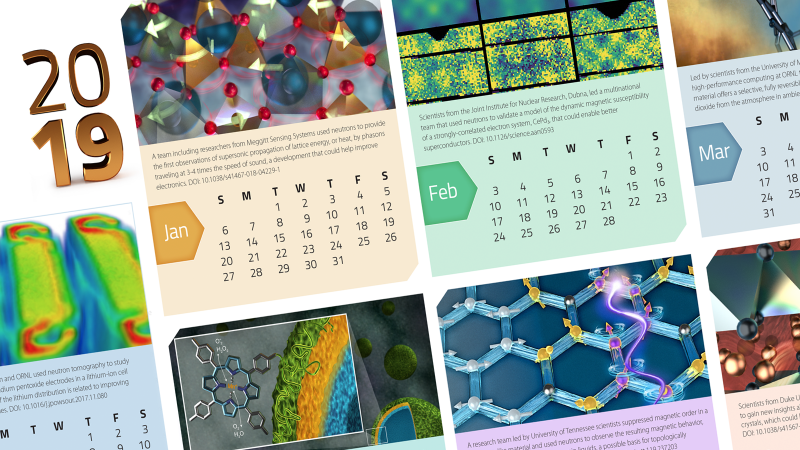For more information on the scientific research and publications featured each month, visit these links:
January: A team including researchers from Meggitt Sensing Systems used neutrons to provide the first observations of supersonic propagation of lattice energy, or heat, by phasons traveling at 3-4 times the speed of sound, a development that could help improve electronics.
DOI: 10.1038/s41467-018-04229-1
February: Scientists from the Joint Institute for Nuclear Research, Dubna, led a multinational team that used neutrons to validate a model of the dynamic magnetic susceptibility of a strongly-correlated electron system, CePd₃, that could enable better superconductors.
DOI: 10.1126/science.aan0593
March: Led by scientists from the University of Manchester, researchers used neutrons and high-performance computing at ORNL to observe how a metal-organic framework material offers a selective, fully reversible and repeatable ability to remove nitrogen dioxide from the atmosphere in ambient conditions.
DOI: 10.1038/s41563-018-0104-7
April: Researchers from the University of Alabama—Birmingham and ORNL used neutrons to demonstrate enhanced antioxidant properties in manganoporphyrin, a synthetic polymer containing tannic acid, a natural antioxidant, that may help improve drug delivery.
DOI: 10.1021/acs.chemmater.7b03502
May: A research team led by University of Tennessee scientists suppressed magnetic order in a graphene-like material and used neutrons to observe the resulting magnetic behavior, which resembled that of quantum spin liquids, a possible basis for topologically protected quantum computer qubits.
DOI: 10.1103/PhysRevLett.119.237203
June: Scientists from Duke University, Argonne National Laboratory, and ORNL used neutrons to gain new insights about “ion jumping” and heat transport in 3D printed superionic crystals, which could lead to better and safer rechargeable batteries.
DOI: 10.1038/s41567-018-0298-2
July: Led by University of Tennessee scientists, researchers used ORNL’s accelerator test facility to make the first measurements of an accelerator beam in six dimensions, (three spatial and three momentum dimensions), to help improve the design of future linear accelerators.
DOI: 10.1103/PhysRevLett.121.064804
August: A team from the University of Utah and ORNL used neutron tomography to study the distribution of lithium in vanadium pentoxide electrodes in a lithium-ion cell and found that non-uniformity of the lithium distribution is related to improving charge/discharge rates in batteries.
DOI: 10.1016/j.jpowsour.2017.11.080
September: ORNL scientists used neutrons to create the first 3D maps of water distribution during cell membrane fusion, potentially leading to treatments for diseases in which normal cell fusion is disrupted, such as Albers-Schönberg disease (osteopetrosis).
DOI: 10.1021/acs.jpclett.8b01602
October: Researchers from Hunan University, the University of Nebraska–Lincoln, and ORNL’s Center for Nanophase Materials Sciences used neutrons to reveal how hydrogen bonding helps convert sunlight into energy in hybrid perovskite materials, which may lead to more efficient solar cells.
DOI: 10.1002/adma.201705801
November: An international team, led by the Chinese Academy of Sciences, Beijing, used neutrons to probe a material exhibiting rare “joint multiferroicity,” with both Type-1 and Type-2 multiferroicity, paving the way for potential improvements in data storage.
DOI: 10.1002/adma.201703435
December: The Spallation Neutron Source ended its first production cycle in fiscal year 2019 at its design power of 1.4 megawatts, which sets a record high power level for a pulsed spallation neutron source and enables higher neutron fluxes to enhance neutron scattering capabilities.
https://goo.gl/bgf38H





